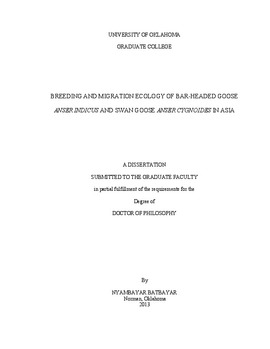| dc.description.abstract | Most waterfowl that breed in Mongolia, part of the semiarid northern region of East Asia, are long distant migrants. They depend on availability of lake, river, and wetland habitats on their breeding and wintering grounds and need suitable staging and stopover sites along their flight routes to complete their migration. Waterfowl in this region have developed important adaptations and strategies to ensure their survival and reproductive fitness across generations. I studied the ecology of two goose species endemic to this semiarid region, the bar-headed goose (Anser indicus) and swan goose (Anser cygnoides), to examine their use of highly-variable, wetland habitats. I studied the breeding biology of bar-headed geese across three summers (2009-2011) while conducting the first systematic nesting study in the semiarid Khangai Mountains region of west-central Mongolia. Bar-headed geese were found nesting on both islands and cliffs, but their daily nest survival was higher at cliff nests and ranged from 0.94 to 0.98 with average nest survival of 42.6% during the incubation period. Information-theoretic models indicated that nest survival decreased with nest age and varied annually. Waterfowl in this region may be limited by available nest sites, but disturbance and depredation also may play a critical role in their population dynamics. I also tracked the migration of both species via satellite telemetry from their breeding grounds to wintering grounds. Satellite tracking data revealed that swan geese migrated through the Yalu River Delta to a wintering area primarily restricted to Eastern China. In contrast, bar-headed geese had a much greater wintering area ranging from southern China to the southern tip of India. Recently, wintering grounds of both species have had significant land cover and land use changes related to global warming and human activities. For the first time, I was able to document unique and narrow migration corridors for both species that were related to landscape features. The migration corridor of bar-headed geese on the Qinghai-Tibetan Plateau was restricted to one biogeographic biome, while swan geese moved across biomes in a loop migration, preferred stopover sites in natural landscapes, avoided areas of eastern China with large scale developments and high human densities, and wintered in the Yangtze River Basin. Migration of bar-headed geese was associated with vegetation green-up as indicated by the Normalized Difference Vegetation Index (NDVI), and geese strategically moved between areas with peak NDVI values extending from their wintering grounds in India, migration stopover areas on the Qinghai-Tibetan Plateau, and breeding grounds in Mongolia. The arrival of bar-headed geese at staging areas during the spring migration was correlated with a decline of green vegetation biomass on their wintering grounds in India and advancement of vegetation green-up in northern latitudes. During the autumn migration, snow cover and land surface temperature corresponded well with their southward movement. These results will have important implications to improve understanding of wild bird biology in this region as well as disease ecology -- waterfowl may contribute to gene flow of avian influenza viruses among different geographical populations of wild and domestic birds through their long distance migration. Species distributions are expected to shift in response to climate change, and swan and bar-headed geese likely will alter their distribution and migratory behavior in response but constrained by both natural habitat availability and human effects limiting their habitats. | en_US |
